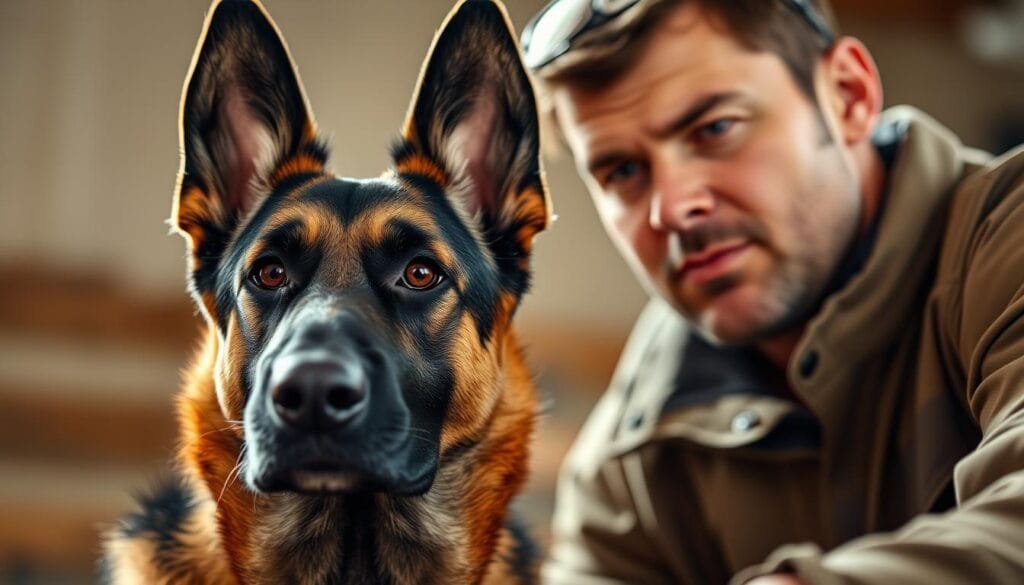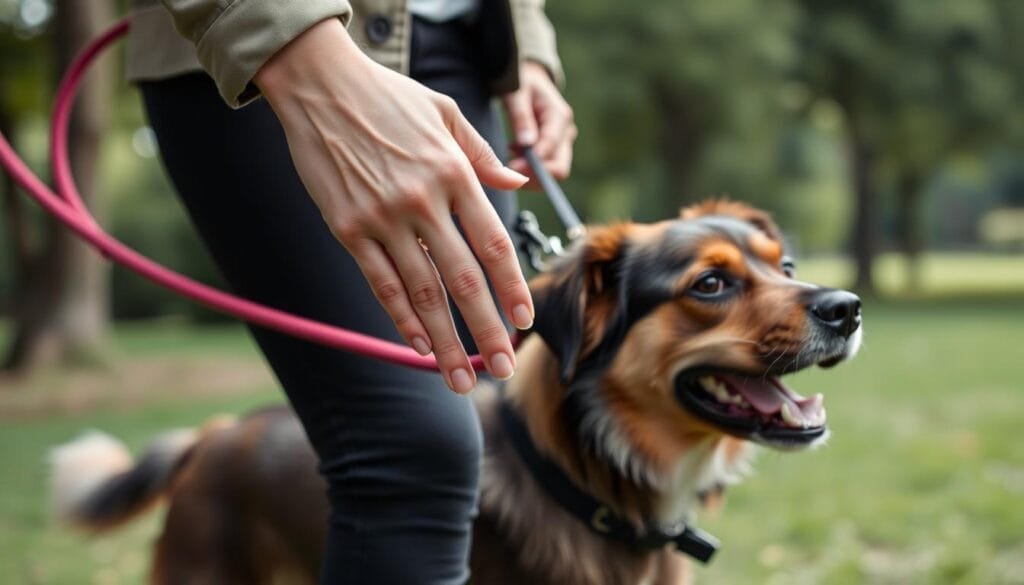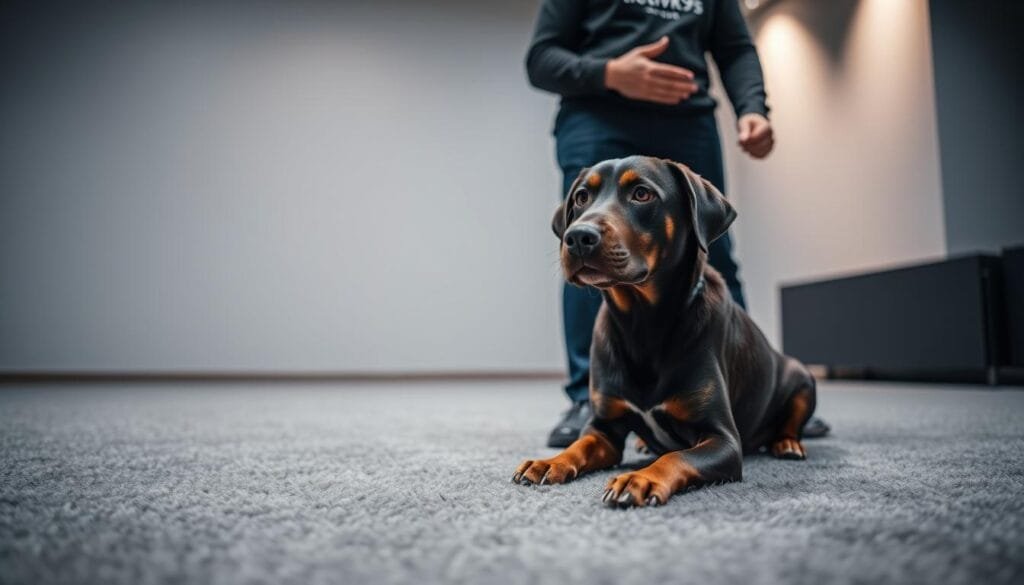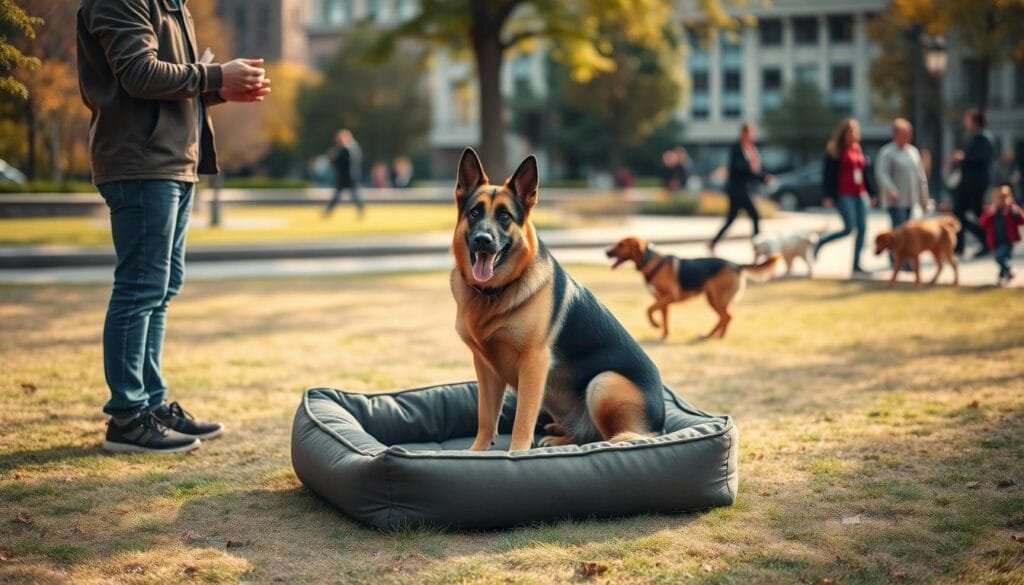Many dog owners face the challenge of their furry friends leaping up during greetings. While this behaviour often stems from excitement, it can become a persistent issue if not addressed. Understanding why dogs jump is the first step toward modifying this habit.
Positive reinforcement techniques, rooted in compassion and consistency, are highly effective in reshaping such behaviours. Drawing from real-life training sessions, this article offers practical strategies to help your pet stay calm during interactions.
By focusing on trust and respect, you can build a stronger bond with your dog while addressing unwanted actions. Small, consistent steps lead to lasting success, and this guide will walk you through the process with clarity and care.
Key Takeaways
- Understanding canine behaviour is essential for effective training.
- Positive reinforcement fosters trust and respect between dogs and owners.
- Consistency is key to modifying unwanted actions.
- Practical strategies are based on real training experiences.
- Small steps lead to significant improvements over time.
Understanding how to stop Dog Jumping on People
Dog jumping is a common yet often frustrating behavior that many pet owners face. It typically stems from excitement and a desire for attention, but it can lead to uncomfortable situations, especially when your furry friend exuberantly greets guests or strangers. Understanding how to stop dog jumping on people is essential for fostering better dog manners and creating a more harmonious environment for everyone involved. With consistent training and the right approach, you can help your dog learn appropriate greeting behaviors.
One effective method for dog manners training is to teach an alternative behavior when your dog feels the urge to jump. For instance, you can train them to sit or wait patiently when meeting new people. Using positive reinforcement techniques, such as treats or praise, helps reinforce this desired behavior and encourages your dog to remain calm instead of leaping onto unsuspecting guests. Consistency is key; your dog needs to associate calm behavior with rewards consistently throughout their interactions.
Incorporating dog jumping solutions into your routine can yield significant benefits over time. When you anticipate visitors, practice commands like “sit” or “stay” before they arrive to establish a calm environment. If your dog does jump, calmly redirect them to a more appropriate behavior without engaging in negative reactions. This consistency will help them understand which actions warrant positive feedback and which will not. With patience and dedication, you will see improvement in your dog’s behavior.
Ultimately, understanding how to stop dog jumping on people is about re-evaluating how we interact with our pets and setting clear boundaries. It’s crucial to ensure that everyone involved – from family members to visitors – applies the same rules when dealing with jumping behaviors. Over time, your dog will learn the appropriate way to greet others, leading to a more enjoyable and stress-free experience for both you and your canine companion.
Leaping up is a natural way for dogs to communicate, but it can become problematic. This behaviour often stems from excitement or a desire for attention. Understanding the reasons behind it is the first step toward addressing it effectively.
Exploring Canine Behaviour and Body Language
Understanding canine behavior and body language is essential for any dog owner. Dogs communicate primarily through their body language, which can reveal a wealth of information about their emotions and intentions. For example, a wagging tail doesn’t always indicate a happy dog; the context and the speed of the wag can signal excitement, anxiety, or even aggression. By learning to interpret these signals correctly, owners can respond appropriately to their pets’ needs and reduce the likelihood of behavioral issues. Recognizing stress signals, such as lip licking or yawning, can enable owners to manage their dogs’ environments better, ensuring a harmonious home.
One area of focus in canine training is teaching impulse control in dogs. Instilling this skill is vital for maintaining a well-behaved companion, as it helps dogs resist the urge to act on impulses that may lead to unwanted behaviors. Techniques such as “wait” and “leave it” can be practiced daily to encourage patience and self-restraint. This type of training is particularly beneficial during encounters with distractions, such as when greeting guests. By reinforcing these behaviors, owners can create a more relaxed atmosphere in the home, allowing dogs to remain calm and composed when visitors arrive.
Puppy training to prevent jumping is another crucial aspect of dog behavior management. Many puppies view jumping as a natural way to greet people with enthusiasm. However, this can be disruptive and potentially alarming to guests. Teaching an alternative behavior, like sitting when someone approaches, can help puppies learn more appropriate ways to express their excitement. Consistency is key, as reinforcing the desired behavior through positive reinforcement will make it a habitual practice for the dog. Moreover, reducing jumping not only makes for more pleasant interactions but also builds the foundation for further obedience training.
In conclusion, understanding canine behavior and body language is foundational for fostering a strong bond between owners and their dogs. By focusing on impulse control and teaching puppies the right behaviors, such as greeting guests calmly, owners can effectively manage their dogs’ actions and create a more enjoyable experience for everyone involved. With patience and consistency, pet owners can witness positive transformations in their pets, ultimately leading to healthier and happier companions.
Dogs use body language to express themselves, and jumping is one way they seek interaction. In the canine world, face-to-face contact is a sign of engagement. However, this doesn’t always align with human expectations.
For example, a wagging tail and raised paws might indicate joy, but to us, it can feel overwhelming. Recognising these cues helps bridge the communication gap between dogs and their owners.
Common Triggers and Underlying Causes
Several factors contribute to jumping behaviour. Door greetings are a frequent trigger, as dogs often associate visitors with excitement. Playful energy and a lack of clear boundaries can also play a role.
Previous experiences, such as inadvertently rewarding jumping with attention, reinforce this behaviour. Environmental factors, like a busy household, can further exacerbate the issue.
| Trigger |
Solution |
| Door greetings |
Teach calm behaviour before opening the door. |
| Playful energy |
Redirect energy into structured activities. |
| Attention-seeking |
Reward calm behaviour and ignore jumping. |
Ignoring jumping can sometimes lead to an extinction burst, where the behaviour temporarily increases before fading. This is a natural part of the learning process.
By understanding these factors, owners can create a foundation for effective training. Addressing the root causes ensures long-term success in modifying this behaviour.
Force-Free Positive Reinforcement Techniques
Force-free positive reinforcement techniques have gained popularity among pet owners and trainers alike for their compassionate approach to canine behavior modification. Rather than relying on punishment or negative consequences, this method emphasizes rewarding desired behaviors, fostering an environment of trust and respect between the dog and handler. By using treats, praise, and play as motivators, owners can effectively encourage their dogs to engage in behaviors that enhance their quality of life and interaction with humans and other dogs.
One common challenge many dog owners face is teaching their pets to stop dog jumping on guests. This can be not only annoying but also potentially dangerous, especially with larger breeds. Through positive reinforcement, owners can train a dog not to jump by first teaching them an alternative behavior, such as sitting or staying when someone enters the home. By consistently rewarding the dog for remaining calm and in a seated position, they begin to associate the arrival of guests with positive experiences, rather than using jumping as a way to greet.
It’s essential to recognize that patience and consistency are crucial when implementing force-free techniques. Training a dog not to jump requires repetitive practice and immediate reinforcement of the desired behavior. This process enhances the dog’s understanding of what is expected in various social situations, ultimately leading to better behavior not just when guests arrive, but in other interactions as well. The focus on positive reinforcement encourages a bond built on trust, making the training experience enjoyable for both the dog and the owner.
Moreover, embracing force-free training methods has lasting benefits beyond the immediate goals of good behavior. These techniques help strengthen the dog’s willingness to learn and explore new commands, creating a mentally stimulated and fulfilled pet. As the dog becomes more confident in their training, owners often notice improvements in their overall behavior and demeanor. By prioritizing kindness and understanding over punishment, pet owners can cultivate a happier, safer environment for both their dogs and their guests.
Training a dog to greet calmly can transform interactions for both pets and their owners. Force-free methods focus on building trust and respect, ensuring your furry friend learns the right way to behave without fear or punishment. These techniques are rooted in celebrating success and reinforcing desired actions.
https://www.youtube.com/watch?v=g6PVdqinCUk
Celebrating Desired Behaviours
Celebrating desired behaviors can be one of the most fulfilling aspects of pet ownership. Our furry friends often communicate their needs and wants in ways that can sometimes be overwhelming, especially when they express excitement through jumping. Training a dog not to jump requires patience, consistency, and positive reinforcement, but the rewarding feeling of seeing your dog respond to your cues is unparalleled. Each small victory, from a calm greeting at the door to sitting quietly when asked, deserves to be celebrated, reinforcing the bond between human and pet.
Creating an environment where desired behaviors are recognized and applauded can transform the training experience. When a dog sits instead of jumping, it’s an opportunity to shower them with praise and perhaps a treat, reinforcing the idea that calm behavior is what we want to see. This positive reinforcement not only encourages repetition of the good behavior but also enhances the dog’s sense of security and happiness. The more we celebrate these achievements, no matter how minor they may seem, the more motivated our pets will be to continue engaging in positive behavior.
Celebrating moments of success isn’t limited to formal training sessions. Everyday interactions provide numerous opportunities to acknowledge and reward desired behaviors. When a dog waits patiently for their food or behaves appropriately around guests, it’s essential to recognize those moments. The joy of seeing a dog thrive in their learning environment is bolstered through consistent encouragement, creating a foundation of mutual respect and understanding.
In this way, our journey of training is not just about correcting undesired behaviors but about nurturing a loving relationship that enhances the quality of life for both dog and owner. Ultimately, the act of celebrating these moments builds a shared language, making the training process enjoyable and enriching, leading to a well-behaved companion who thrives in a harmonious household.
Positive reinforcement relies on rewarding the actions you want to see more of. When your pet remains calm during greetings, celebrate this success with enthusiasm. Use high-value treats, verbal praise, or a favourite toy to reinforce the behaviour.
Consistency is crucial. Practicing these rewards multiple times a day helps your dog understand what’s expected. Over time, the need for treats diminishes, and attention becomes the primary reward.
“Rewarding calm behaviour is the cornerstone of effective training. It’s about teaching your dog that good things happen when they choose the right actions.”
Hand Targeting and Remedial Loading Exercises
Hand targeting and remedial loading exercises are essential tools in dog training, particularly when addressing unwanted behaviors such as jumping up on people. By focusing on these techniques, you can teach your dog appropriate ways to interact with others and promote positive socialization. Hand targeting involves teaching your dog to touch their nose to your hand or another target, which can effectively redirect their energy and create a clearer bond between you and your pet. When you want to stop your dog from jumping on visitors, you can use hand targeting to encourage them to approach you for a reward instead, which fosters better behavior.
Remedial loading exercises complement hand targeting by helping dogs learn balance and body awareness. These exercises typically involve your dog performing specific movements, such as shifts in weight or navigating various surfaces, which can alleviate jumping tendencies by teaching them to focus and maintain control. By engaging your dog in these constructive activities, you help channel their excitement into physical challenges that require concentration and thinking. This shift in mindset is crucial for high-energy dogs that often resort to jumping as a way to express exuberance when greeting friends or family.
Consistency and patience are essential when implementing hand targeting and remedial loading exercises. Start with short sessions, gradually increasing the complexity and duration as your dog becomes more comfortable with the tasks. Each time your dog approaches you without jumping, reward them with treats or praise, reinforcing the desired behavior further. Over time, this positive reinforcement will help them understand that approaching calmly and gently will earn them the attention they crave, effectively teaching them how to stop jumping up on a person altogether.
Additionally, involving your dog in these exercises during routine interactions can solidify the training process. For instance, when guests arrive, invite your dog to perform targeting exercises first to ease their excitement. This approach not only helps curb jumping but also strengthens the bond between you and your dog. Ultimately, by combining hand targeting and remedial loading exercises, you can effectively guide your dog towards more appropriate behaviors, leading to better experiences for both your pet and the people they meet.
Hand targeting is a powerful technique to redirect your dog’s energy. Teach them to touch your hand with their nose instead of jumping. This exercise not only prevents unwanted actions but also strengthens your bond.
Remedial loading involves repetitive practice in low-distraction environments. For example, ask your dog to sit before opening the door. This builds a habit of calm behaviour during exciting moments.
| Technique |
Purpose |
| Hand Targeting |
Redirects energy and prevents jumping |
| Remedial Loading |
Builds calm habits in specific situations |
| Celebratory Rewards |
Reinforces desired behaviours |
These methods are not only effective but also build a foundation of trust. By focusing on positive reinforcement, you create a happier and more confident pet.
How to Stop Dog from Jumping up on a Person
If you have a dog that tends to jump up on people, it can certainly be a frustrating behavior to manage. Many dogs jump as a form of greeting, expressing their excitement and eagerness to interact. However, not everyone appreciates being greeted in such an enthusiastic manner, so it’s important to teach your dog more appropriate ways to say hello. The key is to redirect this instinctual behavior into something more acceptable through consistent training.
One effective strategy to curb dog jumping is to ignore the behavior altogether. When your dog jumps up, simply turn your back and refrain from giving any attention, whether it’s eye contact, verbal commands, or physical affection. This technique teaches your dog that jumping does not yield the desired response. Wait until all four paws are on the ground, and then reward them with praise or treats. This reinforces the idea that calm behavior is what earns them affection, gradually encouraging them to greet you and others without jumping.
Consistency is crucial in this training process. Make sure everyone in your household follows the same rules regarding dog jumping. If one person allows the dog to jump, while others discourage it, the mixed signals can confuse your dog and prolong the undesired behavior. In addition to this, you can teach an alternative behavior such as “sit.” By training your dog to sit before greeting anyone, you create a structured routine that naturally replaces the jumping. Use positive reinforcement to encourage the sit behavior, rewarding your dog each time they respond correctly.
Finally, be patient with your dog as they learn. Changing a behavior that is deeply ingrained takes time and persistence. With dedication and understanding, your dog can learn to express their excitement in a calmer manner. Ultimately, the goal is to foster a trusting relationship built on effective communication, ensuring that both your dog and those they greet can enjoy moments together without the overwhelming urge to jump.
Addressing unwanted behaviours in pets requires patience and the right approach. At activk9s, Trainer Malcolm has developed a force-free method that focuses on building trust and understanding between owners and their furry companions. His techniques are rooted in positive reinforcement, ensuring lasting results without fear or stress.
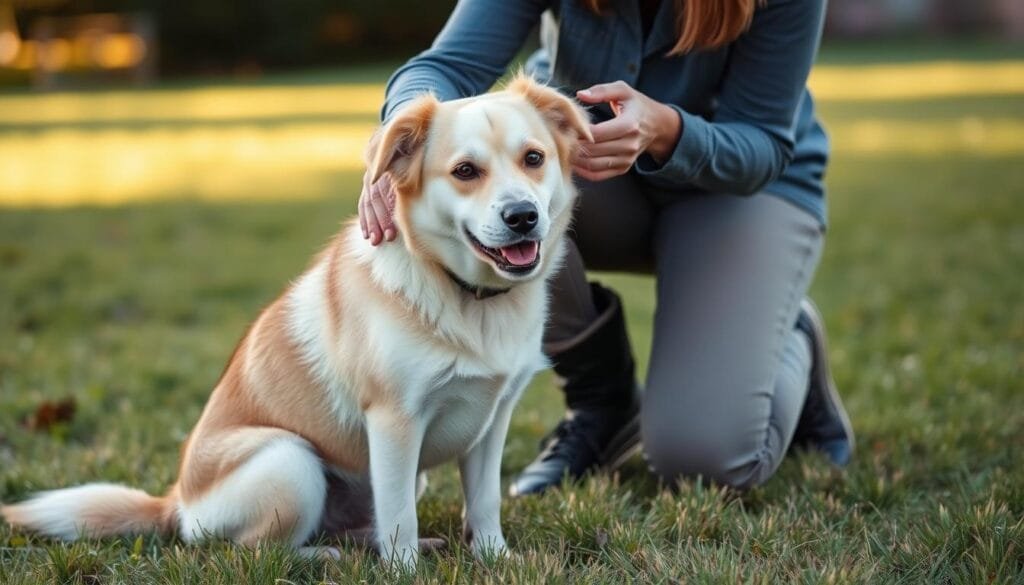
One of the core principles of Malcolm’s approach is using clear signals and markers. For example, teaching a pet to sit before greeting visitors helps redirect their energy. This simple yet effective technique prevents jumping while reinforcing calm behaviour.
Key Steps to Modify Jumping Behaviour
- Use high-value treats: Rewarding calm actions with treats encourages repetition.
- Practice hand targeting: Teach your pet to touch your hand with their nose instead of leaping up.
- Ignore unwanted actions: Withholding attention when they jump helps them understand it’s not acceptable.
- Be consistent: Regular practice ensures the behaviour becomes a habit.
Trainer Malcolm emphasises the importance of consistency. “Small, daily efforts lead to significant changes over time,” he explains. His approach not only addresses the immediate issue but also strengthens the bond between pet and owner.
For those seeking professional guidance, Malcolm can be reached at 089-4120124. His expertise ensures tailored solutions for every unique situation. By combining patience, consistency, and positive reinforcement, you can help your pet greet people politely and confidently.
Practical Training Methods and Management Strategies
Effective training and management strategies can transform how your pet interacts with others. By combining consistency, environmental adjustments, and engaging activities, you can address unwanted behaviours while fostering a positive relationship. This section explores practical approaches to achieve lasting success.

Implementing Consistent Training Practices
Consistency is the cornerstone of successful training. Every family member should follow the same rules to avoid confusing your pet. For example, if one person rewards calm behaviour while another inadvertently encourages jumping, progress will be delayed.
Short, frequent training sessions are more effective than long, infrequent ones. Practicing at specific times, such as when guests arrive, helps reinforce desired actions. Clear cues and immediate rewards ensure your pet understands what’s expected.
Managing Environment and Reward Timing
Environmental management plays a crucial role in preventing unwanted behaviours. Using tools like leashes, crates, or baby gates can temporarily confine your pet during high-excitement moments. This reduces opportunities for jumping while training takes place.
Reward timing is equally important. Recognise and reward calm behaviour immediately to strengthen the connection. High-value treats or verbal praise work best when given at the right moment.
| Management Tool |
Purpose |
| Leash |
Prevents jumping during greetings |
| Crate |
Provides a safe space during high-energy moments |
| Baby Gate |
Controls access to specific areas |
Incorporating Creative Exercise and Enrichment
Incorporating creative exercise and enrichment into a dog’s daily routine is essential for both their physical health and mental well-being. Physical activities can range from traditional walks in the park to more engaging experiences such as agility training or interactive play sessions. The key is to keep the dog mentally stimulated while providing the necessary physical workout. For instance, playing fetch with a twist—like using different toys or changing locations—can make the activity more exciting and rewarding for your canine companion.
Furthermore, it’s vital to consider enrichment activities that stimulate a dog’s mind. Puzzle toys, scent games, and obedience training can provide the mental challenges that keep a dog engaged and reduce anxiety or boredom-related behaviors. Particularly when training a dog not to jump, incorporating structured activities like focus training or “leave it” exercises can redirect their energy and teach them alternative behaviors. Providing a variety of these exercises not only reinforces desired behaviors but also helps build a stronger bond between the owner and the pet.
Engaging a dog in creative exercises allows for exploration and discovery, addressing their natural instincts while providing a stimulating environment. Whether it’s inviting friends over for a puppy playdate or setting up a scavenger hunt in your backyard, each new experience can contribute to a healthier and more balanced dog. When dogs are regularly challenged both physically and mentally, they are less likely to engage in undesirable behaviors and more likely to thrive in their home environment.
Ultimately, the goal is to create a comprehensive routine that fosters physical activity and mental enrichment. By intentionally designing days that incorporate varied forms of exercise and entertainment, owners can cultivate a happy, well-adjusted dog. This holistic approach not only aids in training a dog not to jump but also enhances their overall quality of life, establishing a foundation for long-term behavioral success and companionship.
Physical and mental stimulation are essential for a well-behaved pet. Activities like snuffle mats, puzzle toys, and scent games reduce excess energy that might lead to jumping. These enrichment tools keep your pet engaged and satisfied.
Regular exercise, such as walks or playtime, also helps. A tired pet is less likely to exhibit unwanted behaviours. Combining structured training with creative activities ensures a balanced approach.
By implementing these strategies, you can create a harmonious environment for your pet. Small, consistent efforts lead to significant improvements over time.
Conclusion
Building a calm and respectful greeting habit in your pet is achievable with the right approach. Understanding their behavior is the foundation for effective training. By using positive reinforcement, you can create a bond of trust and respect, ensuring your furry friend learns the right way to greet people.
Trainer Malcolm’s methods, such as hand targeting and remedial loading, provide practical solutions. These techniques redirect energy and build calm habits in specific situations. Consistency is key—small, daily efforts lead to significant changes over time.
Remember, behavioural change requires patience. Improvement is often noticeable within weeks, but lasting success comes with continued practice. Every step forward strengthens the relationship between you and your pet, creating a happier home for both.
With the right methods and support, any behavior challenge can be addressed. Stay committed, and celebrate every small victory along the way.
FAQ
Why does my dog keep jumping on people?
Dogs often jump to seek attention, greet, or express excitement. It’s a natural behaviour, but it can become problematic if not managed properly.
What’s the best way to discourage this behaviour?
Use positive reinforcement techniques like rewarding calm behaviour and ignoring jumping. Consistency is key to success.
Can I use treats to train my dog not to jump?
Yes, treats are effective when used to reward calm behaviour. Pair them with verbal praise for better results.
How long does it take to train a dog to stop jumping?
Training duration varies, but with consistent practice, you may see improvements within a few weeks. Patience and repetition are essential.
What should I do if my dog jumps on guests?
Ask guests to ignore the behaviour until your dog is calm. You can also use a lead to manage their movements during greetings.
Are there specific exercises to help with this issue?
Hand targeting and remedial loading exercises are great for teaching alternative behaviours. These focus on redirecting their energy positively.
How does Malcolm’s approach at activk9s work?
Malcolm’s method uses force-free, science-based techniques to address jumping. It focuses on understanding your dog’s needs and building a strong bond.
Can exercise help reduce jumping behaviour?
Yes, regular exercise and mental enrichment can reduce excess energy, making it easier for your dog to stay calm.
What if my dog jumps on me when I come home?
Wait until your dog is calm before giving attention. Turn away or step back if they jump, and reward them once they settle.
Is jumping a sign of a bigger behaviour problem?
Not always. It’s often a learned behaviour, but if it’s excessive, consulting a professional trainer can help identify underlying issues.

